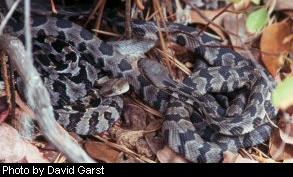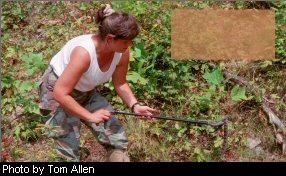

|
WILDLIFE DIVERSITY NOTEBOOK: Timber Rattlesnakes By Jennifer Adams and David Garst
The timber rattlesnake is the most wide-ranging rattlesnake species of North America, occupying diverse habitat types ranging from upland forests to lowland swamps. Vermont and New York west to Wisconsin and Minnesota represent the northern portion of their range. The southern range includes all of the Gulf Coast including the woodlands of east Texas. The eastern mountains along with the Atlantic and Gulf coasts encompass the main portion of the timber rattlesnake's range. Populations have declined in the past century and continue to do so. Declining populations caused timber rattlesnakes to become either absent or limited in several states. Thus, some federal and state agencies recognize the need for research and conservation, and many states now protect the species. Population declines are attributed to human as well as biological factors. Human factors include habitat loss due to development, habitat degradation and unnecessary killings during hunts and roundups, and collecting by individuals. Biological factors such as low reproductive capabilities and climate inhibit the timber rattlesnake's ability to compensate naturally for human factors. The combined effects of these factors result in synergistic, adverse impacts on populations. Some collectors seek timber rattlesnakes for commercial purposes while others seek them for temporary pets or noncommercial purposes. In addition to removing individuals from populations, collecting rattlesnakes for any purpose and for any length of time imposes stress and interrupts biological activities. Capture stresses and interruptions in biological activities affect their ability to forage naturally, complete reproductive activities and locate dens at appropriate times. Timber rattlesnakes are thick-bodied snakes which may reach a length of five feet. Their diet consists primarily of small mammals, but may also include birds and eggs. Timber rattlesnakes are known to live up to 30 years and mature relatively late in life. Females and males of mountain populations do not become reproductively active until about eight years of age.
Rattlesnakes buzz or rattle only to warn approaching humans and predators. They assume a defensive posture or coil their bodies with a raised head and tail when they feel threatened. Similarly, they strike when feeding or as a defense and will retreat if possible. Timber rattlesnakes often remain unnoticed due to their cryptic colors and camouflage patterns. In such instances, their secretive nature and passive behavior allow humans and predators to pass without interference. Most reported bites result from disregarding defensive displays and unnecessarily provoking the rattlesnake. Unexpected encounters with timber rattlesnakes are best avoided by employing a watchful eye in forest settings and by stepping carefully when in timber rattlesnake habitat. It is important to recognize the timber rattlesnake as a key component of forest ecosystems and to understand their ecological role in maintaining a balance within the forests. Jennifer Adams is a master's degree candidate at Marshall University. Garst is an endangered species technician living in Virginia. |
 The timber rattlesnake ( Crotalus horridus ) is possibly the most misunderstood snake species encountered in West Virginia. Timber rattlesnakes are actually quite secretive and passive animals—far from the aggressive creatures perceived by most people. They fulfill their role in maintaining an ecological balance that promotes healthy forests by serving as both predator and prey.
The timber rattlesnake ( Crotalus horridus ) is possibly the most misunderstood snake species encountered in West Virginia. Timber rattlesnakes are actually quite secretive and passive animals—far from the aggressive creatures perceived by most people. They fulfill their role in maintaining an ecological balance that promotes healthy forests by serving as both predator and prey.  One prominent researcher, however, suggests that female reproductive activity in mountain populations may be delayed until 12 years of age. In addition to being long-lived and late-maturing animals, timber rattlesnakes have low reproductive capabilities often impeded by climate. Female timber rattlesnakes reproduce only once about every three years. The young are born in the late summer. Litters average eight young but may vary from as few as one to more than a dozen. Survival of young timber rattlesnakes is very low, further compounding the species' difficulty during years of poor climate and less than average reproduction.
One prominent researcher, however, suggests that female reproductive activity in mountain populations may be delayed until 12 years of age. In addition to being long-lived and late-maturing animals, timber rattlesnakes have low reproductive capabilities often impeded by climate. Female timber rattlesnakes reproduce only once about every three years. The young are born in the late summer. Litters average eight young but may vary from as few as one to more than a dozen. Survival of young timber rattlesnakes is very low, further compounding the species' difficulty during years of poor climate and less than average reproduction.